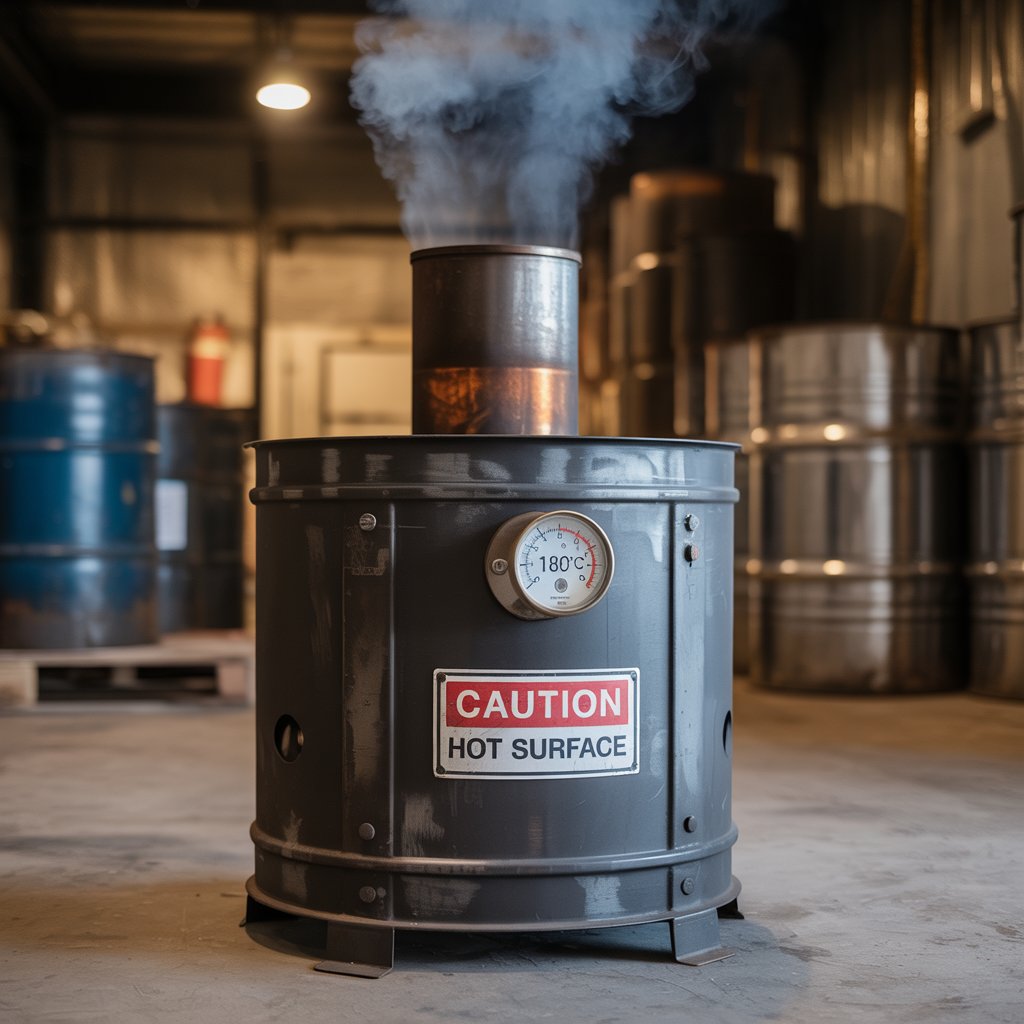In the freezing winters, businesses like auto repair shops, truck depots, farms and construction sites face one problem: heating costs. What if the used engine oil sitting in drums at the back of your garage could warm your facility—without breaking the bank or the planet?
Enter the waste oil heater—also known as a waste oil furnace—an energy smart, eco friendly and legal way to reuse your own engine oil as a heat source.
What is a Waste Oil Heater and How Does It Work?
A waste oil heater is a specialized furnace that burns used oils—like motor oil, hydraulic oil and transmission fluid—to produce heat. Unlike regular oil furnaces, these units are designed to handle impurities and thicker viscosities found in waste oil.
They consist of:
- Preheater: warms oil for better combustion
- Burner unit: atomizes oil into a fine mist for clean burning
- Combustion chamber: generates heat
- Heat exchanger: distributes heat to your facility
Where Does Waste Oil Come From?
If you run any kind of operation that uses machines, vehicles, or tools—chances are you produce more waste oil than you realize. Common sources include:
| Industry | Common Waste Oils Produced |
| Auto repair shops | Engine oil, brake fluid, gear oil |
| Trucking companies | Diesel engine oil, transmission fluid |
| Farms | Tractor and generator oil |
| Construction | Hydraulic oil, compressor oil |
| Manufacturing | Lubricants, coolant oils |
How to Collect and Recycle Waste Oil for Heating
To safely and effectively reuse waste oil, follow these steps:
- Use clean containers: Store oil in dedicated tanks to avoid cross-contamination.
- Filter your oil: Remove solids, metal shavings, and sludge using mesh screens or inline filters.
- Avoid mixing: Never mix solvents, gas, antifreeze, or water with oil.
- Let it settle: Let oil sit to allow water to separate, then drain from the bottom.
Quality matters. Well-filtered oil burns cleaner and extends the life of your heater.

How a Waste Oil Heater Works
A waste oil heater functions through precision engineering. Here’s the process:
- Preheating: Waste oil is heated to reduce viscosity.
- Atomization: The oil is sprayed as a fine mist into the burner.
- Combustion: Mist ignites, generating high heat inside the combustion chamber.
- Heat exchange: Heat is transferred to air or water, then circulated through the building.
Modern systems include:
- Flame sensors
- Draft regulators
- Auto shutoff valves
- Digital thermostats
These ensure clean, safe, and EPA-compliant operation.
This type of used motor oil heating system is ideal for operations with consistent oil output, offering sustainable heat without relying on the grid.
Installation Tips for Waste Oil Heaters: Getting It Right
A proper install saves time, reduces fire risk, and maximizes performance.
Installation checklist:
- Choose location: 5+ feet from flammable surfaces; adequate airflow
- Ventilation: Install chimney or flue pipe to handle exhaust
- ⚡ Power: Connect to a grounded power source
- Clearances: Follow manufacturer’s guidelines (often 18”–36” clearance required)
- Permits: Many states require inspections and local permitting
Pro tip: For most commercial sites, hire a certified HVAC technician familiar with oil-burning appliances.
Why Waste Oil Heaters Are Ideal for Cold Climate Operations
In states where winters hit hard—like Michigan, Colorado, Montana, and North Dakota—reliable, efficient heat is a must.
A waste oil heater offers:
- ✅ Rapid heating for large open bays and garages
- ✅ No reliance on grid-based fuel delivery
- ✅ A use for the oil you’re already collecting
Farmers, contractors, and logistics managers find these heaters invaluable during snowy seasons. Businesses looking for an energy-efficient shop heater will find waste oil units especially appealing due to their dual function of heating and recycling.

Where Waste Oil Heaters Work Best
Waste oil heaters are ideal for businesses that generate their own used oil and need dependable heating—especially in colder climates. Let’s break down the top industries and settings where these systems make the most impact:
️ Auto Repair Shops & Garages
Auto shops are prime candidates because they generate consistent volumes of used engine oil from daily oil changes and engine services. A waste oil heater not only provides warm working conditions in winter but also eliminates the need to pay for oil disposal.
Why it works:
- Constant oil supply
- Open floor plans heat efficiently
- Reduces heating bills and environmental footprint
Farms and Agricultural Barns
Farmers often operate machinery like tractors, combines, and diesel pumps—all of which produce used oil. In rural areas where propane deliveries can be inconsistent or costly, a waste oil heater offers off-grid, low-cost warmth for barns, shops, and greenhouses.
Why it works:
- Remote location compatibility
- Reuses tractor and generator oil
- Heats large, drafty spaces affordably
️ Construction Equipment Yards
Construction businesses with fleets of loaders, backhoes, cranes, and compressors accumulate a lot of oil during maintenance. A waste oil heater can turn that byproduct into energy to heat storage bays, tool rooms, or vehicle staging areas.
Why it works:
- High oil turnover from heavy machinery
- Cuts heating bills for temporary or seasonal buildings
- Keeps equipment and crews warm during winter months
Trucking Depots and Cold-Weather Fleet Hubs
Truck depots and logistics yards often operate around the clock. Their vehicles require regular oil changes, producing a large volume of waste oil. A waste oil heater keeps the service bays warm, reduces operating costs, and ensures vehicles are ready in cold weather.
Why it works:
- Heavy oil consumption
- High heating demands
- Reduces downtime and start-up issues for diesel fleets
Manufacturing Plants in Snowy States
Industrial facilities often heat large interior volumes, which can lead to massive utility costs in winter. If the plant operates equipment that uses lubricants, a waste oil heater can be an efficient way to reduce waste and heating expenses simultaneously.
Why it works:
- Generates consistent oil waste
- Significant heating load
- Aligns with sustainability and ESG goals
Pro Tip:
If your business already pays for heating and produces more than 300–500 gallons of used oil annually, a waste oil heater could turn waste into a valuable energy asset.
Environmental Benefits of Using a Waste Oil Heater
This isn’t just a budget win—it’s an environmental one.
- ♻️ Reduces hazardous waste: Waste oil can contaminate groundwater if not handled properly.
- Cuts emissions: Burning filtered oil produces fewer CO₂ emissions than transporting and refining new fuel.
- ️ Decreases landfill use: Diverts waste oil from illegal dumping or storage tanks.
- Supports circular economy: You generate it, you burn it—on-site reuse.
Using a waste oil heater shows leadership in environmental responsibility.
Waste Oil Heater Cost Savings Examples
Here’s what you stand to save:
| Scenario | Annual Waste Oil | Cost to Heat (Traditional) | Cost with Waste Oil Heater | Annual Savings |
| Auto Shop (4 bays) | 600 gal | $4,500 | $900 (maintenance only) | $3,600 |
| Trucking Depot | 1,200 gal | $8,000 | $1,500 | $6,500 |
| Farm Operation | 400 gal | $3,200 | $800 | $2,400 |
Your waste oil is already paid for—why not turn it into fuel?
Are Waste Oil Heaters Legal and Safe?
Yes—but only if you follow the rules.
EPA Guidelines (Part 279):
- Only burn your own oil or oil from a contracted service
- Must use an approved waste oil burner
- Follow clean air emissions standards
- Keep maintenance logs and disposal records
Never burn:
- Gasoline
- Antifreeze
- Paint thinners or solvents
- Coolant
Choosing the Right Waste Oil Heater for Your Business
Things to consider:
- ️ Size of facility (sq. ft. = BTU needs)
- ️ Oil generation: Do you produce 250+ gallons annually?
- Automation level: Manual fill vs. gravity-fed vs. pump system
- Type of heat: Forced air, hydronic, combo units
Top brands to explore: Clean Burn, EnergyLogic, Lanair, Firelake
Can You DIY a Waste Oil Heater or Should You Go Pro?
With so many YouTube videos and online tutorials showing how to build a waste oil heater using steel drums or old propane tanks, it’s fair to ask: Can I make one myself?
✅ DIY Waste Oil Heater: What You Need to Know
Technically, yes—you can build a basic waste oil burner using scrap metal, a fuel tank, and some simple tools. DIY systems often use:
- Repurposed propane tanks
- Steel barrels
- Shop vac blowers
- Homemade burners
They can work in small, personal garages or off-grid sheds where regulations are relaxed. However…
⚠️ Risks of DIY Waste Oil Heaters
- No EPA certification — illegal in commercial businesses
- ☠️ Toxic emissions from unregulated combustion
- Fire hazard — no flame safety shutoffs or temp regulators
- ❌ No insurance coverage if something goes wrong
- ️ Code violations in many states and cities
Bottom line: If you’re a hobbyist heating a remote shed—go ahead and tinker. But if you’re running a licensed auto shop, farm, or industrial site, a DIY heater could get you fined, shut down, or worse.
How Auto Repair Shops Can Get a Waste Oil Heater (the Right Way)
For commercial facilities, always choose EPA-approved, UL-listed equipment. Here’s how to do it the right way:
1. Buy From a Reputable Manufacturer
Top brands offering code-compliant heaters:
- Clean Burn
- EnergyLogic
- Lanair
- Firelake
- Shenandoah
These units are designed for safe, legal operation and meet federal/state regulations.
2. Work With an HVAC Installer
Certified HVAC contractors can:
- Help size the right BTU output for your building
- Install exhaust flues and fuel tanks safely
- Handle permits and inspections
- Ensure insurance compliance
3. Explore Incentives and Packages
Some suppliers offer:
- Trade-ins for outdated oil burners
- Financing for small and mid-sized businesses
- Bundles with heaters, tanks, and installation
4. Ask Your Oil Hauler
If you already use a service that collects used oil, ask if they sell heaters. Many haulers have partnerships with heater manufacturers and may offer bundled deals or maintenance discounts.
Pro Tip for Shop Owners:
If your shop generates 500–1,000+ gallons of used oil per year, investing in a waste oil heater pays for itself fast. You’re already collecting the fuel—you might as well burn it for free heat.
Waste Oil Heater Costs: What You’ll Spend—and What You’ll Save
Before you make the jump to installing a waste oil heater, it’s important to understand the full cost picture—upfront, ongoing, and long-term savings.
️ Initial Cost Breakdown
| Item | Average Cost (USD) |
| Waste Oil Heater Unit | $3,500 – $8,000 |
| Fuel Storage Tank | $400 – $1,200 |
| Flue/Exhaust System | $300 – $800 |
| Professional Installation | $1,000 – $2,500 |
| Permits & Compliance (Varies by state) | $100 – $500 |
Estimated Total Setup Cost: $5,500 – $13,000, depending on system size and complexity.
Ongoing Costs
Unlike traditional heating systems, waste oil heaters require regular maintenance—but fuel is free (if you generate enough waste oil).
| Expense | Average Annual Cost |
| Filter replacements | $100 – $200 |
| Burner cleanouts | $100 – $300 |
| Annual tune-up (optional) | $150 – $500 |
| Misc. parts (gaskets, nozzles, etc.) | $50 – $150 |
Annual maintenance costs typically fall between $300–$1,000, depending on usage.
♻️ Fuel Cost Savings
If you currently pay for heating oil, propane, or natural gas, the savings from burning your own used oil are significant.
| Fuel Type | Cost per Gallon | Annual Use (Est.) | Annual Cost |
| Propane | $2.50 | 2,000 gal | $5,000 |
| Waste Oil | $0 (onsite reuse) | 2,000 gal | $0 |
Most shops save $3,000–$10,000/year on heating fuel alone.
⏳ ROI: When Does It Pay Off?
If your business produces 500+ gallons of used oil annually, the typical payback period is 1–3 years.
The more oil you generate—and the colder your winters—the faster you’ll break even.
✅ Summary: Waste Oil Heater Cost Snapshot
| Category | Value |
| Setup Cost | $5,500–$13,000 |
| Annual Maintenance | $300–$1,000 |
| Annual Fuel Savings | $3,000–$10,000 |
| Break-Even Period | 1–3 years |
✅ Incentives and Packages for Waste Oil Heaters (USA)
1. Manufacturer Trade-In Programs
Most leading brands offer trade-in deals when you upgrade from an old waste oil burner or standard furnace.
Examples:
-
Clean Burn and EnergyLogic often offer up to $500–$1,000 off for replacing old units.
-
Some include free tanks or pumps with full-system purchases.
2. Section 179 Tax Deduction (IRS)
Waste oil heaters qualify as energy equipment and can be deducted under Section 179.
How it works:
-
Deduct 100% of the equipment cost (up to $1,220,000 in 2024) in the first year.
-
Applies to heaters, tanks, installation labor, and related equipment.
This is a major financial benefit for small businesses!
♻️ 3. State and Local Energy Efficiency Rebates
Some states offer rebates or low-interest loans for energy-saving equipment like waste oil furnaces.
Examples include:
-
California, Minnesota, New York, and Vermont
-
Utility companies like Xcel Energy and Con Edison may offer incentives for switching from propane or electric heat
Use the DSIRE database to check by ZIP code for specific state/local programs.
4. Bundled Installation Packages
Vendors and HVAC contractors often bundle:
-
Heater + Fuel Tank + Pump Kit + Chimney System
-
With free delivery, discounted installation, or extended warranties
Some even offer turnkey packages with:
-
EPA compliance certification
-
Permitting assistance
-
On-site staff training
5. Financing Options (0% APR or Deferred Payment)
Most top suppliers (e.g., EnergyLogic, Lanair) offer:
-
12- to 60-month financing
-
$0 down / same-as-cash deals
-
Lease-to-own options for small businesses
Example Package (EnergyLogic):
“Eco Heat Bundle 500”
-
140,000 BTU Heater
-
250-gallon tank
-
Pump + Digital thermostat
-
10-year heat exchanger warranty
-
Free shipping & tax deduction eligibility
Maintenance Tips to Keep Your Waste Oil Heater Running Efficiently
Good maintenance = longer lifespan and cleaner burns.
- Clean heat exchanger monthly
- Empty ash pans weekly
- Check air filters and combustion chamber
- Test fuel quality often
- Schedule seasonal tune-ups
Keep a maintenance log and train your team on safe operation.
Who’s Using Waste Oil Heaters Successfully?
- Auto Repair Shop, Ohio: Saved $3,800/year on propane
- Freight Hub, Minnesota: No longer pays for oil disposal
- Family Farm, Idaho: Reuses tractor and generator oil to heat livestock barn
- Metal Fabricator, Pennsylvania: Cut CO₂ emissions by 18% with integrated heater system
Waste Oil Heaters vs. Other Heating Options
| Heater Type | Fuel | Cost to Run | Eco Impact | Maintenance |
| Waste Oil Heater | Recycled oil | Low | High eco benefit | Moderate |
| Propane Heater | Propane tanks | High | Fossil fuel | Low |
| Electric Heater | Grid electricity | Very high | Grid-dependent | Low |
| Fuel Oil Furnace | New oil | High | Moderate | Moderate |
FAQs About Waste Oil Heaters
Q1: Can I burn any oil in a waste oil heater?
Only clean used oils—never solvents or chemicals.
Q2: How much waste oil do I need per year?
At least 250–300 gallons for ROI. Larger shops see better savings.
Q3: Are they noisy or smelly?
Modern units are quiet and clean-burning when maintained.
Q4: Can I install one myself?
Yes, but professional installation ensures safety and compliance.
Q5: Is a permit required?
Usually yes. Always check local building and fire codes.
Final Thoughts: Turning a Dirty Problem into a Clean Solution
If you’re already paying to dispose of used oil and struggling with heating costs, a waste oil heater is a no-brainer. You’ll:
- ✅ Lower your energy bills
- ♻️ Reduce your environmental footprint
- Improve operational self-sufficiency
- Show customers your commitment to sustainability
In cold climates, your waste isn’t waste—it’s heat.





